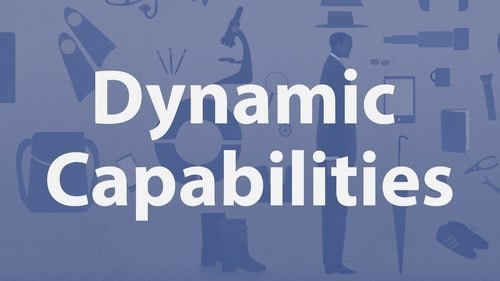Dynamic Capability can be defined as the inherent capability of the organization to optimally and purposefully adapt and catapult the organization’s resource base. This management theory was defined by David Teece, Gary Pisano, and Amy Shuen in their 1997 paper Dynamic Capabilities and Strategic Management.
It focuses on the company’s ability to build, integrate, and reconfigure the internal and external competencies to address the rapidly market environment that is always dynamic and volatile in nature.
Table of Contents
Breaking Down Dynamic Capabilities :
The main aim and objective of the theory are to provide impetus to the firm’s to achieve and sustain the competitive advantage and carve a distinguished identity in the industry giving a tough competition to its arch rivals in the market.
The goal is to identify the various factors and dimensions of the firm’s centric capabilities that can optimally utilize and work as a source of advantage and to explain how the myriad combinations of competences and resource can be developed, deployed, and protected having a long-term approach and vision in mind.
It helps in formulating the path of strategic management and planning the company strategy that helps in gaining the competitive advantage. The concept of Dynamic Capabilities and Strategic Management mainly focuses on the internal strengths of the organization such as workforce and capital investments rather than harping on the external forces such as government policies and market trends to sustain the dynamic nature of the market and gain the competitive advantage.
In the year 1995, Barney highlighted on how the management should harp on the internal resources and suggested to answer the below-mentioned questions as a part of the evaluation process to gain the competitive advantage in the market:
Value: Do the firm’s available resources and the inherent capabilities are strong enough to add value in exploiting the various growth opportunities available and to neutralize the threats that are hovering on the overall growth of the business owing to the volatility of the market?
Rareness: The firm has to check and analyze the external competitive environment by figuring out that how many of the competitive firms possess the same values and capabilities to fight the dynamic changes in the market and can give a tough competition to the firm.
Imitability: The firm also has to find and figure that the other firms without the optimal resources and capabilities go through the cost disadvantage by undergoing the process of acquiring the same as compared to the firms that already possess the same.
What are the benefits of Dynamic Capabilities in Strategic Management?
- By opting and following the concept of Dynamic Capabilities and Strategic Management, the firm is able to expand its business operations on the national and international levels through the ways such as business alliances, mergers, and joint ventures.
- On an internal level, the firm is able to come up with the new and innovative line of products and services as per the latest market trends and satiating the needs and demands of the customers. The new product line can be launched for the existing set of loyal customers and to attract the customers in the new target market.
The process of Dynamic Capabilities and Strategic Management :
1) Learning
The first and foremost stage in the process of Dynamic Capabilities and Strategic Management involves the key staff members and managers along with the management to learn and analyze their basic routines leading healthy interactions that lead to the effective ways of problem-solving. It also involves finding out and avoiding the strategic blind spots and any dysfunctional activities that are posing as a threat to the growth of the business. It also involves making the optimum and appropriate use of the strategic alliance and acquisitions to bring in new and novel strategic assets to the firm through the external resources.
2) Acquiring New Assets
The high level of competitive advantage also requires acquiring new assets by the way of integrating technological factors and external activities through the alliances and partnerships formed.
3) Transforming the existing line of assets
To attain the rapid internal and external transformation adhering to the changing market dynamics and growing competition in the market, it is important for the firm to reconfigure the firm’s current asset structure. It is imperative for the firms to develop the processes to make the changes in an inexpensive manner whilst attaining the reconfiguration of the assets before the dawn of the competition. The entire procedure can be supported by decentralization, strategic alliances, and local autonomy.
4) Co-specialization
Another facet of the Dynamic Capabilities and Strategic Management is the aspect of Co-specialization that involves the strategic combination of physical assets, human resources, and intellectual properties of the firm that are developed over a period of time that work more valuable in a combination rather than using them individually or separately. It helps in giving a firm a sustainable competitive advantage in the market.
Example of Dynamic Capabilities and Strategic Management :
Both the technological giants Apple and IBM are the perfect examples of Dynamic Capabilities and Strategic Management. They are the tow dynamically competent and technologically advanced companies whose dynamic capabilities have enabled and empowered them to grow and evolve with dynamic change in the market facing the competition head one and generating high levels of profits plus retaining the loyal base of customers.
The firm Apple is one of a kind and a unique case as the company is not a technological leader but has successfully proven itself as a master at marketing technologically-based products to consumers and developing the unique and enticing features that people value and pay the premium for.
Whereas IBM is a true and bonafide technological innovator in its home ground as well in the external markets where it operates. The Firm has successfully transitioned from electromechanical tabulating machines to mainframe computers, and today stand as a successful and highly renowned brand in the market offering high-end IT-based services, software’s and cloud computing business.
As per the researchers, the part of the success of Apple and IBM’s is because of their ability to overcome the downside of “path dependence” — the factor that the past experience and history play in what a company is proficient of doing and what it chooses to do. Companies with high path dependence have quite a difficult time changing what they do, even when the world around them is changing and evolving at a very fast pace. They astutely follow the same path over and over again despite what is going on in the external environment.
For both Apple and IBM, Fortunately for Apple and IBM, path dependence has not been as strong as it has been for their contemporaries. Both the firms possess different levels of strengths and are managed in a different manner, they have both been able to successfully enter new businesses and markets and have been reinventing themselves in a profound and inspirational manner.
The aspect of leadership has enabled them to adapt to the changing market environments and face the competition.
Conclusion
There is no such concept as a generic ability to adapt to the changing market environment. The companies that develop specific, dynamic capabilities allows them to move more agilely in times of rapid change, and the odds are better that they will succeed.
Liked this post? Check out the complete series on Strategy

